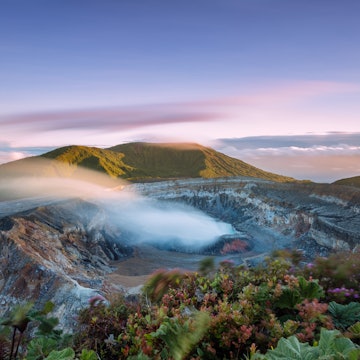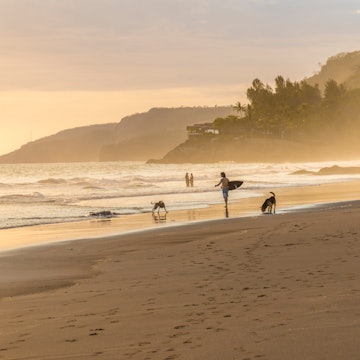
The top national parks in Costa Rica for hiking, volcanoes, wildlife and more
Apr 27, 2022 • 11 min read

At Parque Nacional Manuel Antonio, explore sloth-filled forests – then lie out on the beach © John Seaton Callahan / Getty Images
Costa Rica’s famously rich landscapes and abundant wildlife showcase pura vida.
Within the Central American country’s relatively small borders, visitors will find 28 national parks, in addition to dozens of other refuges, reserves and conservation regions.
From beaches to volcanoes to waterfall-strewn forests full of capuchin monkeys, hummingbirds, parrots and other wildlife, Costa Rica’s national parks are simply treasures. The sheer wealth of outdoor escapes, however, can be a little overwhelming for visitors deciding where to go in what order.
So whether you’re looking for a sunrise hike, a surf spot or a tenacious trek to a caldera so active you can only stay for 20 minutes at a time, we’ve rounded up the 15 best national parks in Costa Rica.

Go up, up and away at Parque Nacional Chirripó
Mountaineers won’t want to miss this national park. While much of the Cordillera de Talamanca is difficult to access, Costa Rica’s highest peak, Cerro Chirripó (12,500ft/3820m), is the focus of popular two-day ascents from San Gerardo de Rivas.
The only way up Chirripó is on foot. Although the trekking routes are challenging, watching the sunrise from such lofty heights is one of the country’s undeniable highlights. Most hikers go up to Crestones Base Lodge, then summit at sunrise the following day.

Swim with sharks at Parque Nacional Isla del Coco
Around 310 miles (500km) southwest of the Costa Rican mainland, Isla del Coco is a natural wonder that teems with wildlife, including the largest schools of hammerhead sharks on the planet. For that reason, divers descend from all corners, often venturing out on liveaboard trips with companies like Aggressor and Undersea Hunter. There’s also some fascinating pirate history here – and apparently some buried treasure.
At Parque Nacional Manuel Antonio, seek out sloths, then take a dip
Featuring lush jungle, picture-perfect beaches and craggy headlands, this relatively small coastal reserve (1680 acres) absolutely brims with wildlife – and visiting humans. As you wander its lovely trails, you’ll catch a glimpse of dangling sloths, squawking toucans and playful monkeys, then stumble on breathtaking views of the sea and nearby islands. To beat the crowds and maximize wildlife sightings, arrive early – or better still, buy your tickets the afternoon before and walk straight in the following day.

Fawn over the fauna at Parque Nacional Tortuguero
This misty and green coastal park sits on a broad floodplain crisscrossed by a jigsaw of canals. Often called the “mini Amazon,” Parque Nacional Tortuguero is a place of intense biodiversity that includes more than 400 bird species, 60 known species of frog, 30 species of freshwater fish and three monkey species, as well as the threatened West Indian manatee. Caimans and crocodiles can be seen lounging on riverbanks, while freshwater turtles bask on logs.
More than 150,000 visitors a year come to ply the canals by boat and take in the wildlife, particularly to watch turtles lay eggs. This is the most important Caribbean breeding site of the green sea turtle, 40,000 of which arrive every season to nest. Of the seven species of marine turtle in the world, six nest in Costa Rica, and four nest in Tortuguero. Various volunteer organizations address the problem of poaching with vigilant turtle patrols. Park headquarters is at Cuatro Esquinas, just south of Tortuguero village. Strong currents make the beaches unsuitable for swimming, so you’ll have stick to observing the wondrous wildlife.
Visit Parque Nacional Cahuita for prime turtle viewing
At just 3.9 sq miles (10 sq km), this tiny but beautiful reserve is one of the more frequently visited national parks in Costa Rica. The reasons are simple: the nearby town of Cahuita provides attractive accommodations and easy access, and the park has white-sand beaches, a coral reef, coastal rainforest and a small lagoon that all burst with wildlife. The arrival of cruise ships and weekenders detracts from the tranquility: plan accordingly, and arrive early if possible.
There are north and south entrances to the park; visitors who enter the park at Kelly Creek to the north are not required to pay the US$5 entrance fee, though donations are welcomed. Keep in mind that the Costa Rican park service is habitually underfunded, and tourist dollars provide important support for education, conservation and maintenance programs.

Take a (very) long beach stroll at Parque Nacional Marino Ballena
Famous for its wide, 2.5 mile(4km)-long beach, this small but important marine park protects coral and rock reefs surrounding several offshore islands, along with migrating humpback whales, dolphins and nesting sea turtles. (The best times of year for whale spotting are from December to April and July to November.) You can walk along the famous, sandy “whale’s tail” at low tide only; at high tide much of the beach is covered.
At the end of the tail are rock pools, where kids will enjoy searching for small marine animals. However, ferocious waves break at the end of the tail, so it’s not suitable for swimming – be sure to keep the kids well away from the water.
Reserva Biológica Hitoy-Cerere’s wildlife makes it worth the long journey
Only the most intrepid of nature enthusiasts will make the journey to Hitoy-Cerere, about 37 miles (60km) south of Puerto Limón and only accessible by 4WD along a rugged dirt track. The 38-sq-mile (99-sq-km) reserve sits on the edge of the Cordillera de Talamanca; it’s characterized by varying altitudes, evergreen forests and rushing rivers. This is one of the wettest reserves in the park system, inundated with 157–236in (4000–6000mm) of rain annually.
Naturally, wildlife abounds. The most commonly sighted mammals include gray four-eyed opossums, tayras (a type of weasel), and howler and capuchin monkeys. Since the area is home to more than 230 avian species, there are plenty of ornithological delights as well, including keel-billed toucans, spectacled owls and the green kingfisher.
And you can hardly miss the Montezuma oropendola, whose massive nests dangle from the trees like twiggy pendulums. The moisture, in the meantime, keeps the place hopping with various species of poison-dart frog.

Go macaw-spotting at Parque Nacional Carara
Carara is the famed home of one of Costa Rica’s most charismatic bird species, the scarlet macaw. While catching a glimpse of this tropical wonder is a rare proposition in most of the country, macaw sightings are virtually guaranteed at Carara. You can also keep your eye out for 400 other avian species flitting around the canopy, as well as Costa Rica’s largest crocodiles in the waterways. (It’s best to leave your swimsuit at home.)
The park’s four trails can easily be explored in half a day; come early to maximize wildlife sightings. An umbrella is important in the wet season (and occasionally needed in the dry months), and make sure you have insect repellent.
You might have Parque Nacional Juan Castro Blanco all to yourself
Near the geographic center of the country, this little-visited national park is where five of Costa Rica’s major rivers originate. Since this 55-sq-mile (143-sq-km) reserve has a sizable but little maintained trail network and few facilities, you’ll likely have the park to yourself. Most folks head to the visitor center (4WD required) managed by Montaña Sagrada Natural Reserve, and walk the three trails there. One leads to a dreamy lagoon named Ponzo Verde.
The infrequent foot traffic means that your chances of spotting unusual species is greatly increased. Keep your eyes peeled for tapirs, ocelots, curassows, quetzals and black guans. You can also admire the many splendid orchids.

Descend into a volcanic crater at Parque Nacional Volcán Poás
Here’s your chance to get frighteningly close to an extremely active volcano, which last erupted in 2017. At an elevation of 885ft (2708m), mighty Poás is clasped by 7540-year-old lava; visitors can peer right into the 853ft(260m)-deep crater, which has a striking turquoise lake at its center. Note that visits are now restricted to 20 minutes.
Daily visitor numbers are strictly controlled by a convoluted online booking system, requiring an initial registration with ID, then payment. Advance booking on the website is essential or you may be turned away at the gate. Upon purchasing a ticket, you sign a waiver of liability outlining the increase in toxic volcanic gases at the crater (sulfur dioxide, sulfuric acid, hydrochloric acid and carbon dioxide).
Since the booking system has been known to crash, book well in advance of your visit, and download your confirmation in advance as cellphone signal is scarce on the volcano. Check the park opening status before you visit; temporary closures have been known to happen due to ash and gas emissions.
Get soaked at Parque Nacional Tapantí-Macizo Cerro de la Muerte
This 224-sq-mile (580-sq-km) national park preserves the verdant northern slopes of the Cordillera de Talamanca and is the wettest reserve in the country, getting a sopping 315in (8000mm) of precipitation a year. The park’s largest peak, the Cerro de la Muerte (Mountain of Death; 11,322ft/3451m) is also the highest point on the Costa Rican section of the Interamericana. “El Salto” is an easy 328ft (100m) walk up steps to a lookout point with waterfall and mountain views.
There are three other trails of varying difficulty and lengths, running up steep slopes or along the flat riverbed. The ranger’s office at the park entrance has maps and info on each path. Toilets, picnic tables and water are available in the park, as is a small exhibit with info on nature in the area, plus insects and stuffed animals for sale. There are birdwatching and orchid-spotting opportunities aplenty. Look for the turn-off to the park on Ruta Nacional 408.
Wander the wild wetlands of Parque Nacional Palo Verde
At the head of the Golfo de Nicoya, the 76-sq-mile (198-sq-km) Parque Nacional Palo Verde is a wetland sanctuary in Costa Rica’s driest province. The park’s shallow permanent lagoons are gathering points for wildlife, including the greatest concentrations of waterfowl and shorebirds in Central America. Several miles of hiking trails wind through the forests; boat tours (just outside the park) are an excellent way to visit the wetlands. Come during the driest months for greater concentrations of birds and animals and fewer mosquitoes.
All of the region’s major rivers drain into this basin, creating habitats including mangrove swamps, marshes, grassy savannas and evergreen forests. The park also harbors plenty of wildlife: more than 300 species of birds have been recorded here, such as rare black-crowned night herons and the endangered jabiru. The park is also home to many mammals, including the largest population of jaguarundis (wildcats) in Costa Rica; there are also numerous reptiles – such as crocodiles reportedly up to 16ft (5m) in length.
The dry season (December to March) is the best time to visit; flocks of birds tend to congregate in the remaining lakes and marshes, and trees lose their leaves, allowing for clearer viewing. That said, the entire basin swelters during the dry season, so bring adequate sun protection – and you’ll still want insect repellent. During the wet months, large portions of the area are flooded, and access may be limited.

Have a soak at Parque Nacional Rincón de la Vieja
Given its proximity to Liberia, this park feels surprisingly uncrowded and remote. Named after the steamy main attraction – the active Volcán Rincón de la Vieja (6217ft/1895m) – the park includes several other peaks in the same volcanic range, including Volcán Santa María (6286ft/1916m). The park exhales geothermal energy thanks to multihued fumaroles, hot springs, bubbling pailas (mud pots) and a young, feisty volcancito (small volcano); all can be visited on foot along well-maintained if sometimes steep trails.
Most visitors to the park come here for the hot springs, where you can soak to the sound of howler monkeys overhead; many of the springs are reported to have therapeutic properties. Several lodges just outside the park provide access and arrange tours. You can also book transportation and tours from Liberia.
Admire Parque Nacional Volcán Tenorio’s celestial waters
Since this park’s heavenly blue river, waterfalls and lagoons are among the most spectacular natural phenomena in Costa Rica, the park is known to locals simply as Río Celeste (though it’s officially named after the soaring 6286ft/1916m Volcán Tenorio). From the El Pilón ranger station at the park entrance, a 3-mile (5km) out-and-back hiking trail winds through the misty forest, covering all the park’s highlights.

Meet the leatherbacks at Parque Nacional Marino Las Baulas de Guanacaste
This land-and-sea park encompasses the entire beach at Playa Grande, as well as the adjacent land and 85 sq miles (220 sq km) of ocean. This is one of the world’s most important nesting areas for the critically endangered baula (leatherback turtle). In the evenings from October to March, rangers lead tours to witness the turtles’ amazing cycle of life.
Despite increased conservation efforts, fewer leatherbacks are nesting on Playa Grande each year. To protect the dwindling population, park rangers collect eggs and incubate them to increase their chances of survival. Even so, sea turtles must hatch on the beach and enter the water by themselves, otherwise memory imprinting does not occur and the hatchlings will never return to their birthplace to nest. It’s estimated that only 10% of hatchlings survive to adulthood – so treasure this natural spectacle, and keep your distance.
You may also like:
Costa Rica’s 7 most unique places to stay include tropical igloos and tree houses
5 road trips in Costa Rica that aren't for the faint of heart
19 incredible places to visit in Costa Rica right now















